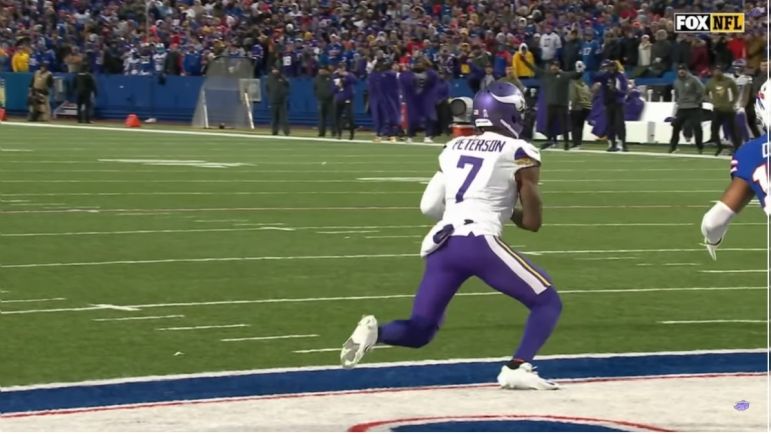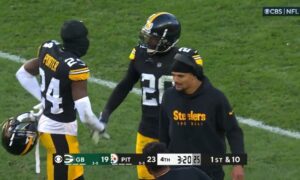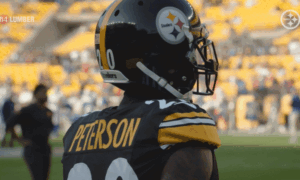There is no denying that Patrick Peterson is one of the best defensive backs of the 21st century, first bursting onto the scene as a dynamic return man before ascending to perennial Pro-Bowl status at the boundary cornerback position. In total, Peterson earned Pro Bowl honors in each of his first eight seasons in Arizona, adding first-team AP All-Pro appearances in 2011, 2013, and 2015, ultimately earning a spot on the NFL 2010s All-Decade team.
After signing with the Vikings ahead of the 2021 season, when he was set to turn 31, Peterson struggled at times, finishing the season with 45 tackles, two tackles for losses, an interception, and five passes defended, all while missing four games with injury. In his second season in Minnesota, Peterson, at least statistically speaking, appeared to find the fountain of youth, recording 66 tackles, three tackles for losses, five interceptions, and 15 passes defended. In fact, his five interceptions and 15 passes defended were the highest figures that he had posted in a single season since his second season in Arizona, all the way back in 2012.
Moving into the advanced statistics, which Pro Football Reference only tracks back to 2018, the numbers tell a bit of a different story. Last season, Peterson gave up 53 catches for 696 yards and five touchdowns, 309 of which came after the catch. He allowed a 59.6% when targeted, 7.8 yards per target, and a passer rating of 79.6 when targeted. Compare that to Cameron Sutton. He allowed 35 completions for 388 yards and four touchdowns, 118 of which came after the catch in 2022. He also allowed a 47.9% completion percentage, 5.3 yards per target, and a 65.3 passer rating when targeted. Given those statistics, it becomes tough to argue that Pittsburgh upgraded at the position, even before factoring age.
With Sutton set to be 28 and coming off his best season and Peterson set to be 33 at the start of next season, it is clear that Pittsburgh ultimately bet on the talent and depth in this year’s draft class, likely viewing Peterson as a stopgap for this upcoming season. In all fairness, it is important to note that Sutton was charted with a missed tackle rate of 10.4% this past season, with Peterson posting an extremely low 4.3% figure on a higher volume of attempts.
This is all to say that while Peterson still has his moments in coverage, relying on his savvy veteran IQ and still world-class ball skills to take calculated chances to jump routes and produce takeaways, he does not offer the snap-to-snap consistency that Pittsburgh is looking to replace following the departure of Sutton. That much was clear in my evaluation of his performance against Buffalo this past season, where he struggled to consistently throttle down and match routes from both press and off-man coverage, but rebounded with a pair of high-level reps, which produced a fourth quarter red zone interception and an overtime game=clinching interception in the high red zone.
Likewise, if Pittsburgh’s front seven stays healthy, there is precedent for an aging corner who has lost his early career burst to thrive behind a pass rush that protects against long developing, vertical passing concepts, that player being Joe Haden. With all of that out of the way, let’s get into some tape of Peterson’s Week 9 performance from last season, a game in which he finished with four tackles and a pair of interceptions for 46 return yards. In that game, he allowed 5 catches (83.3 % completion) for 76 yards (12.7 yards per target), 15 of which came after the catch, good for a passer rating of 79.2.
In that respect, it serves as a perfect microcosm to evaluate both the positives and negatives that come with signing Peterson at this stage of his career. Playing in a more zone-heavy scheme in Minnesota, Peterson functioned best playing out of a side shuffle, where he could avoid having to transition from a backpedal and mask his declining speed.
Here, working from a side-shuffle skate technique, Peterson aligns with inside leverage to the receivers wide split, keying Josh Allen in his drop while weaving to close space and squeeze the receiver into the sideline. Peterson has a nice feel playing from this technique, taking a perfect angle and eliminating the fade route before it can even declare downfield. From this technique, Peterson is at his best playing from MOD coverage (man on demand) in pattern match zone schemes, like the Cover 3 match scheme we see here.
Naturally, while the side-shuffle skate technique has its benefits, the major weakness of the technique centers around a lack of vision on the receiver. Oftentimes, when working against skate technique corners, talented route runners can exploit this by navigating the defenders blindspot to generate separation on intermediate and vertical patterns.
Here, working in what appears to be cone coverage to the boundary (corner and safety bracket #1 receiver, with corner playing from outside leverage and able to cut shallow inside releases), Peterson picks up Stephon Diggs in motion, initially playing patiently from a square backpedal, but quickly opening into a crossover run as his cushion is threatened. As he opens to turn and run as the receiver declares up the sideline, Peterson fully turns his back to Diggs, leaving him well out of phase to close to the catch point as Diggs works back to the sideline on a comeback.
Particularly on reps where he has safety help, it is frustrating to see Peterson flip his hips prematurely. Reps like this show his clear lack of trust in his once great long speed. The former Jim Thorpe Award winner posted a 4.34 40-time at the 2011 NFL Scouting Combine and is still adjusting to the reality of playing patiently and effectively as his athleticism declines.
While he doesn’t align in press coverage nearly as frequently as he used to, Peterson is still effective when asked to play from a trail technique, undercutting any in or out breaking routes and leaving vertical responsibilities to his safeties. While Minnesota did not play straight-man coverage often, 2-Man Under served as a safe and effective way to maximize its veteran cornerbacks’ skill sets.
Here, Peterson aligns in press coverage. Showing solid patience at the line before disrupting Gabe Davis’s release with a two-hand jam, he works into a trailing position and undercuts the in-breaking route to take away any throwing lane. While he lacks the speed to carry vertical patterns, his route recognition and physicality at the line of scrimmage make him effective from a trail technique, where can play from the shoulder and undercut routes to generate takeaways.
While it is a risky bet, the Steelers will likely be forced to leave Peterson in isolated man coverage without vertical safety help, as they play Cover 1 at a high rate. While Peterson prefers to play from off-man alignments when left on an island, he will still occasionally press to muddy the quarterback’s pre-snap reads, doing so with mixed results.
Here, Peterson is left in an isolated matchup with Diggs in a Cover 1 Robber scheme. Opening the gate prematurely but doing a nice job of keeping his eyes glued to the receiver’s hip, allows him to stay patient, close to the upfield shoulder, and remain in phase at the top of the route. While Diggs generates some separation with a nice “throw-by” move, Peterson’s tight coverage up to that point forces Josh Allen to quickly move onto his next progression after a quick glance.
Even had Allen ultimately targeted Diggs with a well-thrown ball, Peterson was still well in phase to contest the catch point and play through the hands. Overall, this is a nice rep working in isolated press coverage against one of the game’s premier route runners.
One of the most obvious reasons that Peterson favors the skate technique over a traditional backpedal centers around a lack of trust in his ability to transition and carry receivers vertically from his pedal. This lack of trust often forces him to open the gate prematurely, leaving him susceptible to receivers crossing his face on intermediate in-breaking routes. Chief among the veteran tools that he uses to combat this deficiency is the speed turn, where he can effectively stay in phase with receivers on intermediate breaking routes even after opening the gate prematurely to protect against vertical routes.
Here, working against Davis, Peterson plays from depth, staying patient in his pedal before opening the gate, preparing to turn and run if the receiver works up the sideline. As Davis cuts across his face, Peterson does a phenomenal job to speed turn and remain connected to the upfield shoulder, plastering the receiver as he works across the field. The speed turn is a heavily featured technique in his off-coverage toolbox and will help him match routes at all three levels of the field in Pittsburgh.
Naturally, as with anything in life, compensating in one area can open up exploitable weaknesses in another area. While the speed turn is undeniably an effective tool to recover when out of phase — and is heralded by some of the game’s greatest coaching minds, namely Nick Saban — it is best used as a situational recovery tool rather than a primary one in coverage.
Here, once again he is matched up against Davis in off-man coverage. At the snap, Peterson initially shows patience in his pedal, but quickly opens the gate as the receiver threatens his cushion. As he feels Davis work across his face, Peterson once again works to utilize his speed turn, but loses his footing at the top of the route, allowing easy separation.
While the ball was out well before his stumble, this rep shows why it is important not to become over reliant on the speed turn; it is best categorized as a high risk/high reward maneuver in coverage. Moving forward, Peterson would be best served to stay patient and create more contact at the top of routes, using his strength to disrupt receivers rather than working to challenge them athletically in space.
After an up and down first three quarters of the game, Peterson stepped up, showcasing his still-dominant ball skills and generating a pair of takeaways to spark a Vikings’ road comeback. Here is the first rep, with the Bills facing a fourth and goal, holding a 27-16 lead and threatening to effectively finish the game with a score.
At the snap, Peterson does a nice job of matching a speed out from Isaiah McKenzie, plastering in a scramble drill and squeezing the receiver into the sideline. As Allen continues to drift to his right, Peterson stays connected to the receiver while keying the quarterback, allowing him to drift into the throwing lane and intercept a pass intended for Dawson Knox.
It’s hard to overstate how impressive of a rep this is. Peterson effectively eliminates Allen’s first read with a physical re-route while staying active and aware to rob the crosser in a scramble-drill situation. This rep was part of a 14-point swing. Minnesota would drive and make it a one possession game at 27-23 following a C. J.Ham rushing touchdown. In the red zone, where space is limited and receivers cannot threaten him vertically, Peterson is still among the best in the game.
Fast forward to overtime, with Minnesota holding a 33-30 lead and Buffalo in position to attempt a game-tying field goal or end the game with a touchdown. Facing second and 10 from the Minnesota 20-yard line, Peterson finds himself matched up against Davis in a quarters scheme. He is responsible to carry any vertical release (anything that breaks beyond five yards) from the #1 receiver.
At the snap, Peterson patiently gives ground in his skate technique. Working to the upfield shoulder as Davis declares inside on the post route, he turns to locate the football. Once he establishes contact with the receiver, he stops to undercut the underthrown pass to secure a game-clinching interception. While Peterson’s lack of high-end movement skills were exploited at times throughout the game, his playmaking ability in coverage and elite ball skills showed up in a big way down the stretch. Particularly in MOD coverage, when playing from pattern match zones, Peterson is still extremely effective at keying and jumping routes from his skate technique.
Ultimately, Peterson’s performance against Buffalo last season serves as a microcosm of what Pittsburgh is getting from the incoming, soon-to-be 33-year-old free agent signee. While it may be unwise to leave him in isolated man coverage matchups at the frequency that Pittsburgh has done in recent years, he has shown enough veteran savvy to work in tandem with Minkah Fitzpatrick in these situations.
While Peterson will likely give up vertical separation and explosive plays in the passing game at times, he will undoubtedly add value in his ability to add timely turnover production to a Teryl Austin-led defense which tied for the league lead in interceptions this past season. Likewise, in Pittsburgh’s zone-coverage looks, Peterson’s route recognition and ball skills will add another dynamic playmaker on the backend.
In Levi Wallace, Minkah Fitzpatrick, Damontae Kazee, and Patrick Peterson, Pittsburgh fields a veteran secondary that should flourish through great pre- and post-snap communication. With the signing of Peterson, one thing is for certain: Pittsburgh is getting a very different player than the one it lost in Cameron Sutton. Whether the Steelers tinker with their defensive scheme to maximize Peterson’s strengths and weaknesses remains to be seen and will be something to monitor looking forward to camp and the preseason.








